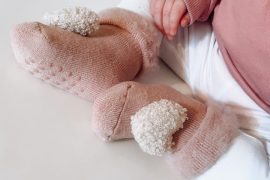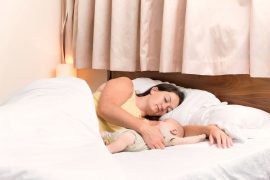- Swaddling is a parent-led strategy to reduce night wakings and to encourage very young babies to sleep deeper and longer. Why would this be a problem? Sleep is developmental and babies will sleep longer stretches when it is developmentally appropriate for them to do so. We don’t want babies sleeping deeply or for too long before they are ready, because this is a protective mechanism against SIDS: they need to wake often for their survival.
- You have to transition out of the swaddle at some stage and personally I would rather have a baby integrate the reflex more naturally and managing that process, than trying to struggle through transitioning them out of a swaddle which often comes at the same time that you’re going through the 4-month sleep progression! We know that babies (especially newborns) wake a lot, so I believe the focus should be on supporting mum and dad to manage sleep deprivation and getting as much rest as they can, than trying to expect or encourage babies to sleep longer than they are ready for.
- Swaddles have become a marketing tool to get vulnerable parents to spend more money. First you swaddle them, then you transition them into this other product, and then another product, then another. All of these things and the messaging that goes with them, are subconsciously telling you that a product can replace your arms and your responsiveness – they tell you to trust someone else as the authority on your baby, not to trust yourself and your baby. Save yourself some money or instead invest in support for yourself, like a doula or a cleaner, so that you are focusing on caring for your newborn and resting yourself.
- I’m all about helping you connect to your instincts, and I advocate for babies to have this too (after all, a reflex = instinct!). I think it’s important to help our little ones trust their bodies, and it is never too early to start.
Sleep is developmental and babies will sleep longer stretches when it is developmentally appropriate for them to do so.
It is always up to each individual family to decide whether or not to swaddle – informed decision making is what matters. Some babies, especially those prematurely born, do respond well to the swaddle and if it works for your family, that is great! Some babies really don’t like the restriction of the swaddle, so my biggest recommendation is to tune into your baby and see what they need.
If you choose not to use a swaddle, here are some ways to help manage the Startle Reflex
MYTH: Swaddling recreates what it feels like to be in the womb.
In utero, babies are free to move – they are unrestricted to wriggle around, kick about and access their hands (did you catch your babe sucking their thumb during an ultrasound?). By swaddling them so tightly that that cannot freely move, this is not recreating the womb – it is more like putting them in a baby straight jacket.
Check out some tips below for what you can do instead of swaddling.
- Firstly, go into newborn sleep with expectations based on what is biologically normal – not based on what is socially expected. Babies are meant to wake a lot and parents are meant to respond – don’t try and fight your biology and your instincts.
- Provide skin-to-skin contact on your chest where they will be able to hear your heartbeat, regulate their temperature through yours, be comforted by your smell and touch, and they will have easy access to the breast (they are experiencing hunger and thirst for the first time). Breastfeeding and skin-to-skin and all the snuggles are the new umbilical cord!
- Learn about safe bedsharing so that you can keep baby close and support them to manage their startles while optimising the sleep that you can get.
- Trust your baby’s communication – if they are hungry, feed them; if they are crying, pick them up and soothe them; if they want to be close to you; keep them close; if you try swaddling them and they don’t like it; don’t swaddle them.
- Allow lots of free movement and “tummy time” – placing your baby on your chest is perfect for this and supports the integration of the reflex.
- The key to preventing the startle reflex from happening too much is to keep baby close! Contact napping, snuggles, breastfeeding and bedsharing. Trust that with time, it will integrate – and if it doesn’t then you can see a paediatric occupational therapist (best if you can find one that specialises in retained reflexes).
Trust your baby’s communication – if they are hungry, feed them; if they are crying, pick them up and soothe them; if they want to be close to you; keep them close; if you try swaddling them and they don’t like it; don’t swaddle them.
Why did swaddling become such a widely used strategy?
In modern-day parenting, we have many demands on our time – we are expected to still do so much, even with a newborn. Babies are also expected to sleep alone in a bassinet or cot and every conversation that you have will include being asked if they are a “good baby” (hint: “are they sleeping through the night yet?”). In addition, we are typically quite accustomed to being in control. So when we are awake throughout the night with a baby who is waking a lot (as newborns do!) and we are tending to them and doing our best to get them back to sleep and back down in the bassinet, THEN we have to wake up in the morning and even though we are exhausted, we “do all the things” like cooking and cleaning, or socialising and entertaining visitors (while also posting perfect pictures on social media)…it’s no wonder we want to find ways that we can control how our baby sleeps (and therefore resulting in us getting more sleep).
As with so many things in the parenting world, our modern Western culture impacts the way we see babies and especially how we see and manage sleep. The sleep training culture runs deep and it is so ingrained in us – we are trained out of our instincts early on. We are told that we should not be responding to our babies so that we don’t “spoil” them, but they still need input, so all of the products and methods have been invented to “replace” the parent so that we can “get back” to our lives.
Sarah is your Baby Sleep Tour Guide & Mama Mentor – supporting you to understand biologically normal infant sleep, with an attachment focus, so that you can optimise sleep and accept your little one’s normal patterns & needs. She’s passionate about challenging the mainstream narratives of baby & toddler sleep, and of motherhood – empowering mums to make choices aligned with their values of responsive gentle parenting, but without the self-sacrifice. Sarah is an Aussie mum and offers online private sleep consults as well as a small group motherhood support program, plus in-person sessions for clients in the Adelaide Hills – you can find her on Instagram @blossomandsnooze and her website https://www.blossomandsnooze.com.










